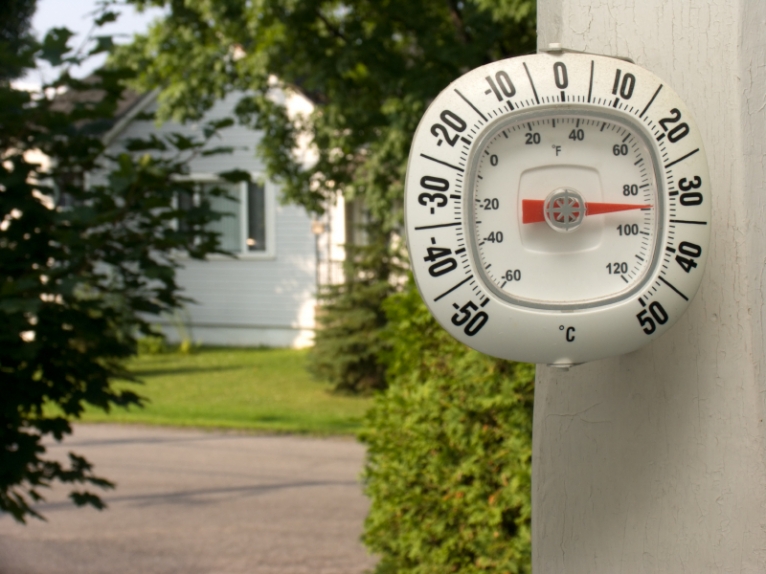
Simple and inexpensive actions can help you save energy and money during the warm spring and summer months. | Photo courtesy of iStockphoto.com/eyedias.
Here you’ll find strategies to help you save energy during the spring and summer when the weather is warm and you are trying to keep your home cool. Some of the tips below are free and can be used on a daily basis to increase your savings; others are simple and inexpensive actions you can take to ensure maximum savings through the spring and summer. For more ways to stay cool while saving energy, check out our Energy Saver 101 infographic, covering everything you need to know about home cooling.
If you haven’t already, conduct an energy assessment to find out where you can save the most.
Also check out tips to save energy during the fall and winter.
USE YOUR WINDOWS TO GAIN COOL AIR AND KEEP OUT HEAT
- If you live in a climate where it cools off at night, turn off your cooling system and open your windows while sleeping. When you wake in the morning, shut the windows and blinds to capture the cool air.
Learn more about natural ventilation. - Install window coverings to prevent heat gain through your windows.
Find out about window treatments and coverings that can improve energy efficiency.
OPERATE YOUR THERMOSTAT EFFICIENTLY
- Set your thermostat as high as comfortably possible in the summer. The smaller the difference between the indoor and outdoor temperatures, the lower your overall cooling bill will be.
- Keep your house warmer than normal when you are away, and lower the thermostat setting to 78°F (26°C) only when you are at home and need cooling. A programmable thermostat can make it easy to set back your temperature.
Find out how to operate your thermostat for maximum energy savings.
Also see the ENERGY STAR® June 5, 2008, podcast for video instructions on operating your programmable thermostat. - Avoid setting your thermostat at a colder setting than normal when you turn on your air conditioner. It will not cool your home any faster and could result in excessive cooling and unnecessary expense.
USE FANS AND VENTILATION STRATEGIES TO COOL YOUR HOME
- If you use air conditioning, a ceiling fan will allow you to raise the thermostat setting about 4°F with no reduction in comfort.
Learn more about using a ceiling fan to increase cooling efficiency.
Find ENERGY STAR ceiling fans. - Turn off ceiling fans when you leave the room. Remember that fans cool people, not rooms, by creating a wind chill effect.
- When you shower or take a bath, use the bathroom fan to remove the heat and humidity from your home. Your laundry room might also benefit from spot ventilation. Make sure bathroom and kitchen fans are vented to the outside (not just to the attic).
Find ENERGY STAR ventilating fans.
KEEP YOUR COOLING SYSTEM RUNNING EFFICIENTLY
- Schedule regular maintenance for your cooling equipment.
Learn about operating and maintaining your air conditioner, evaporative cooler, or heat pump. - Avoid placing lamps or TV sets near your room air-conditioning thermostat. The thermostat senses heat from these appliances, which can cause the air conditioner to run longer than necessary.
Learn additional tips for operating a room air conditioner efficiently. - Vacuum registers regularly to remove any dust buildup. Ensure that furniture and other objects are not blocking the airflow through your registers.
DON’T HEAT YOUR HOME WITH APPLIANCES AND LIGHTING
- On hot days, avoid using the oven; cook on the stove, use a microwave oven, or grill outside.
- Install efficient lighting that runs cooler. Only about 10% to 15% of the electricity that incandescent lights consume results in light—the rest is turned into heat.
Learn more about your options for efficient lighting.
Find out when to turn off your lights.
Purchase ENERGY STAR lighting products. - Take advantage of daylight instead of artificial lighting, but avoid direct sunlight.
Learn more about strategies for efficient daylighting. - Wash only full loads of dishes and clothes. Consider air drying both dishes and clothing.
Learn more about efficient dishwashing and laundry. - Take short showers instead of baths.
Learn more ways to reduce your hot water use. - Minimize activities that generate a lot of heat, such as running a computer, burning open flames, running a dishwasher, and using hot devices such as curling irons or hair dryers. Even stereos and televisions will add some heat to your home.
Learn more about avoiding heat buildup in your home.
KEEP HOT AIR FROM LEAKING INTO YOUR HOME
- Seal cracks and openings to prevent warm air from leaking into your home.
Learn more about air sealing new and existing homes. - Add caulk or weatherstripping to seal air leaks around leaky doors and windows.
Find how to select and apply the appropriate caulk.
Learn how to select and apply weatherstripping.
Find out other ways to improve the energy efficiency of your windows.
LOWER YOUR WATER HEATING COSTS
Water heating can account for 14% to 25% of the energy consumed in your home.
- Turn down the temperature of your water heater to the warm setting (120°F). You’ll not only save energy, you’ll avoid scalding your hands.
Find other strategies for energy-efficient water heating.
